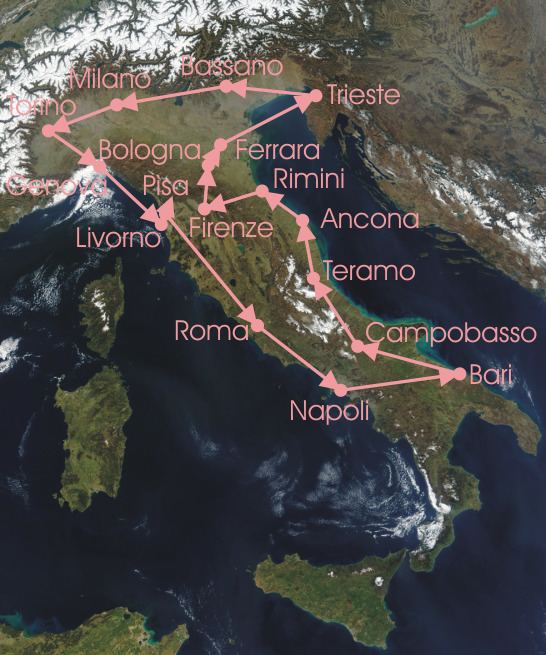Dates 19 May – 10 June Distance 3,712.7 km (2,307 mi) | Stages 17 Winning time 121h 17' 17" | |
 | ||
Second Francesco Camusso (ITA) | ||
The 1934 Giro d'Italia was the 22nd edition of the Giro d'Italia, a cycling race organized and sponsored by the newspaper La Gazzetta dello Sport. The race began on 19 May in Milan with a stage that stretched 169.2 km (105 mi) to Turin, finishing back in Milan on 10 June after a 315 km (196 mi) stage and a total distance covered of 3,712.7 km (2,307 mi). The race was won by the Learco Guerra of the Maino team. Second and third respectively were the Italian riders Francesco Camusso and Giovanni Cazzulani.
Contents
Favourite Alfredo Binda retired during the 6th stage. Guerra took over the maglia rosa from the climb specialist Francesco Camusso in the decisive time trial stage from Bologna to Ferrara.
Participants
Of the 109 riders that began the Giro d'Italia on 19 May, 52 of them made it to the finish in Milan on 10 June. Riders were allowed to ride on their own or as a member of a team; 52 riders competed as part of a team, while the remaining 66 competed independently. There were eight teams that competed in the race: Bianchi-Pirelli, Dei-Pirelli, Ganna-Dunlop, Gloria-Hutchinson, Legnano-Hutchinson, Maino-d'Alessandro, Olympia-Spiga, and Olmpique.
The peloton was primarily composed of Italians, but contained many French and Belgian riders. The field featured three former Giro d'Italia champions in five-time winner and current champion Alfredo Binda and single race winners, Francesco Camusso and Vasco Bergamaschi. Other notable Italian riders that started the race included Learco Guerra, Giuseppe Olmo, Remo Bertoni, and Domenico Piemontesi. Félicien Vervaecke, a Belgian rider who went on to achieve great success at the Tour de France, entered the race. Belgian Jef Demuysere was seen as a favorite to win the race after his victory in the Milan–San Remo earlier in the season.
Classification leadership
The leader of the general classification – calculated by adding the stage finish times of each rider – wore a pink jersey. This classification is the most important of the race, and its winner is considered as the winner of the Giro.
In the mountains classification, the race organizers selected different mountains that the route crossed and awarded points to the riders who crossed them first.
The winner of the team classification was determined by adding the finish times of the best three cyclists per team together and the team with the lowest total time was the winner. If a team had fewer than three riders finish, they were not eligible for the classification.
Il Trofeo Magno (English: the Great Trophy) was a classification for independent Italian riders competing in the race. The riders were divided into teams based on the region of Italy they were from. The calculation of the standings was the same for the team classification. At the end of the race, a trophy was awarded to the winning team and it was then stored at the Federal Secretary of the P.N.P. in their respective province.
The rows in the following table correspond to the jerseys awarded after that stage was run.
